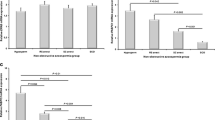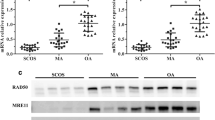Abstract
The expression of corticosteroids and regional expression 16 (CR16) and neural Wiscott-Aldrich syndrome protein (N-WASP) was studied in the testes of men with idiopathic azoospermia by (1) immunohistochemistry and Western blot to detect the expression of CR16 and N-WASP protein, (2) reverse transcription with the polymerase chain reaction (RT-PCR) to determine the amounts of CR16 and N-WASP mRNA, and (3) double-staining immunofluorescence and laser scanning confocal microscopy (LSCM) to demonstrate the co-localization of CR16 and N-WASP proteins. Immunohistochemistry revealed CR16 and N-WASP proteins in the Sertoli cells, specifically in the Sertoli cell-spermatogenic cell junctions (SspJs) in the epithelium of the seminiferous tubules. RT-PCR indicated that the relative amounts of CR16 and N-WASP mRNA were significantly decreased in men with idiopathic azoospermia, although the ratio of CR16 and N-WASP mRNA was approximately 1:1 in both groups of men. Western blot showed the presence of the CR16 monomer and N-WASP in all tissues examined, but the relevant bands were paler in men with idiopathic azoospermia than those in healthy men. The distribution of CR16 and N-WASP was similar in the epithelium of seminiferous tubules based on double-staining immunofluorescence and LSCM, thereby suggesting that CR16 and N-WASP were co-localized in the SspJs as a CR16/N-WASP complex. The decreased levels of CR16 and N-WASP in the testes of men with idiopathic azoospermia compared with healthy men and the co-localization at the SspJs as a CR16/N-WASP complex in the epithelium of seminiferous tubules suggest that CR16 and N-WASP play a role in the pathogenesis of azoospermia.





Similar content being viewed by others
References
Grove BD, Vogl AW (1989) Sertoli cell ectoplasmic specializations: a type of actin-associated adhesion junction? J Cell Sci 93:309–323
Ho HY, Rohatgi R, Ma L, Kirschner MW (2001) CR16 forms a complex with N-WASP in brain and is a novel member of a conserved proline-rich actin-binding protein family. Proc Natl Acad Sci USA 98:11306–11311
Lee NP, Cheng CY (2004) Adaptors, junction dynamics, and spermatogenesis. Biol Reprod 71:392–404
Lie PP, Chan AY, Mruk DD, Lee WM, Cheng CY (2010) Restricted Arp3 expression in the testis prevents blood-testis barrier disruption during junction restructuring at spermatogenesis. Proc Natl Acad Sci USA 107:11411–11416
Masters JN, Finch CE, Nichols NR (1994) Rapid increase in glycerol phosphate dehydrogenase mRNA in adult rat brain: a glucocorticoid-dependent stress response. Neuroendocrinology 60:23–35
Masters JN, Cotman SL, Osterburg HH, Nichols NR, Finch CE (1996) Modulation of a novel RNA in brain neurons by glucocorticoid and mineralocorticoid receptors. Neuroendocrinology 63:28–38
Miki H, Miura K, Takenawa T (1996) N-WASP, a novel actin-depolymerizing protein, regulates the cortical cytoskeletal rearrangement in a PIP2-dependent manner downstream of tyrosine kinases. EMBO J 15:5326–5335
Morita Y, Manganaro TF, Tao XJ, Martimbeau S, Donahoe PK (1999) Requirement for phosphatidylinositol-3'-kinase in cytokine-mediated germ cell survival during fetal oogenesis in the mouse. Endocrinology 140:941–949
O'Sullivan E, Kinnon C, Brickell P (1999) Wiskott-Aldrich syndrome protein, WASP. Int J Biochem Cell Biol 31:383–387
Pollard TD, Beltzner CC (2002) Structure and function of the Arp2/3 complex. Curr Opin Struct Biol 12:768–774
Rossi P, Sette C, Dolci S, Geremia R (2000) Role of c-kit in mammalian spermatogenesis. J Endocrinol Invest 23:609–615
Rowe PJ, Comhaire FH, Hargreave TB, Mahmoud AMA (2000) WHO manual for the standardized investigation, diagnosis and management of the infertile male. Cambridge University Press, Cambridge
Snapper SB, Rosen FS (1999) The Wiskott-Aldrich syndrome protein (WASP): roles in signaling and cytoskeletal organization. Annu Rev Immunol 17:905–929
Suetsugu S, Banzai Y, Kato M, Fukami K, Kataoka Y (2007) Male-specific sterility caused by the loss of CR16. Genes Cells 12:721–733
Suzuki T, Sasakawa C (1998) N-WASP is an important protein for the actin-based motility of Shigella flexneri in the infected epithelial cells. Jpn J Med Sci Biol 51:S63–S68
Vogl AW, Pfeiffer DC, Mulholland D, Kimel G, Guttman J (2000) Unique and multifunctional adhesion junctions in the testis: ectoplasmic specializations. Arch Histol Cytol 63:1–15
Vogl AW, Vaid KS, Guttman JA (2008) The Sertoli cell cytoskeleton. Adv Exp Med Biol 636:186–211
Wang M-Y, Wang X-Z, Sun Y, Zhang J-H (2007) Advance in the relationship between Sertoli cell cytoskeleton and spermatogenesis. Prog Vet Med 28:77–80
Wang Y-M (2009) The role of Sertoli cells in the testes spermatogenesis and its damage in the radiation. J Clin Rehabil Tissue Eng Res 13:3503–3506
Weiler MC, Smith JL, Masters JN (1996) CR16, a novel proline-rich protein expressed in rat brain neurons, binds to SH3 domains and is a MAP kinase substrate. J Mol Neurosci 7:203–215
Author information
Authors and Affiliations
Corresponding author
Additional information
This work was supported by a grant from the National “Tenth Five Years” Key Technologies R&D Programme, China (no. 2004BA720A33-01).
Prof. C. Xiong directed this investigation, Dr. Y. Zhang greatly supported the experimental aspects of this work, Zina Wen and Lian Hu made extensive contributions to the study, and Wenjuan Pang was responsible for proofreading of the text.
Rights and permissions
About this article
Cite this article
Xiang, W., Wen, Z., Pang, W. et al. CR16 forms a complex with N-WASP in human testes. Cell Tissue Res 344, 519–526 (2011). https://doi.org/10.1007/s00441-011-1159-9
Received:
Accepted:
Published:
Issue Date:
DOI: https://doi.org/10.1007/s00441-011-1159-9




